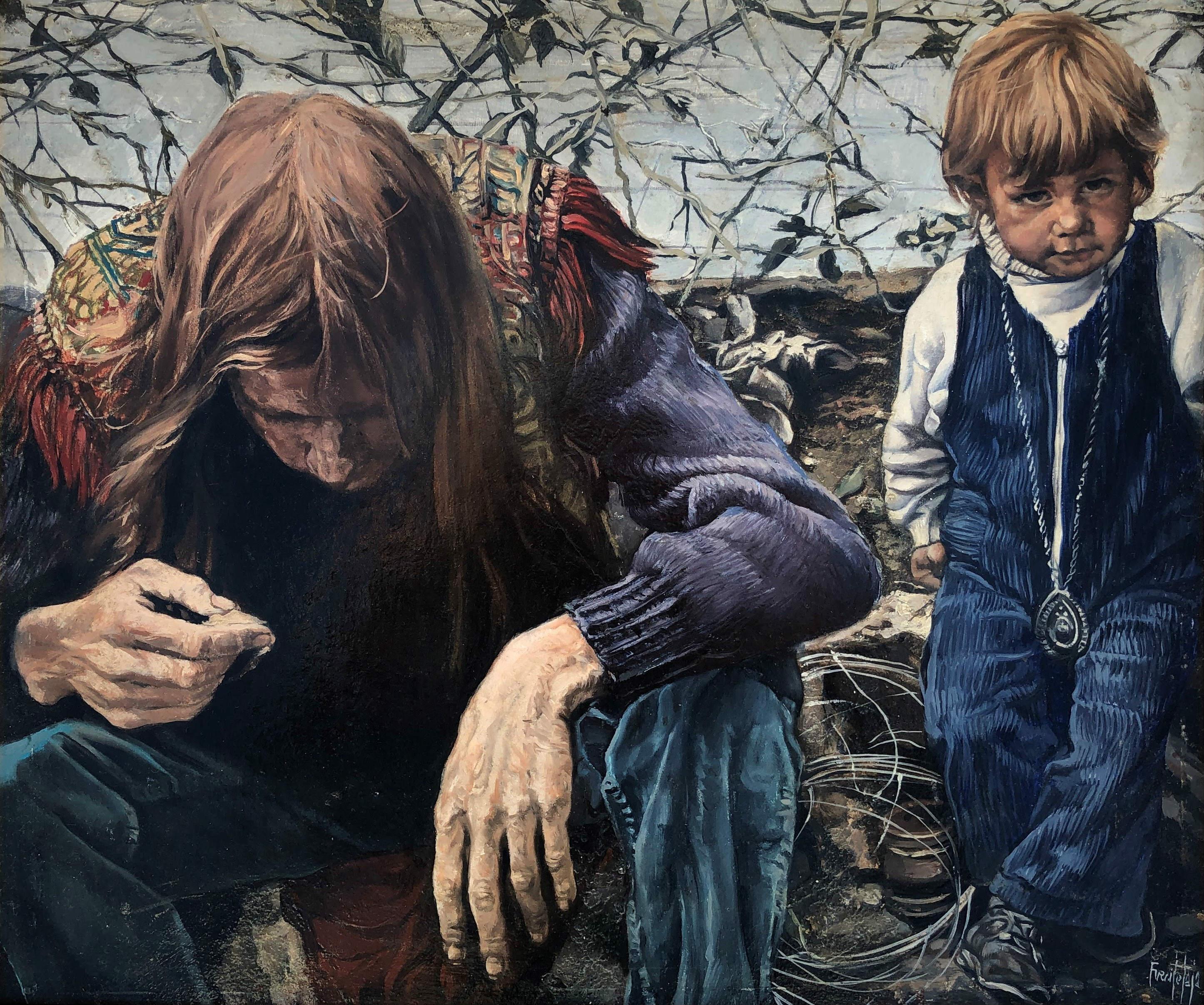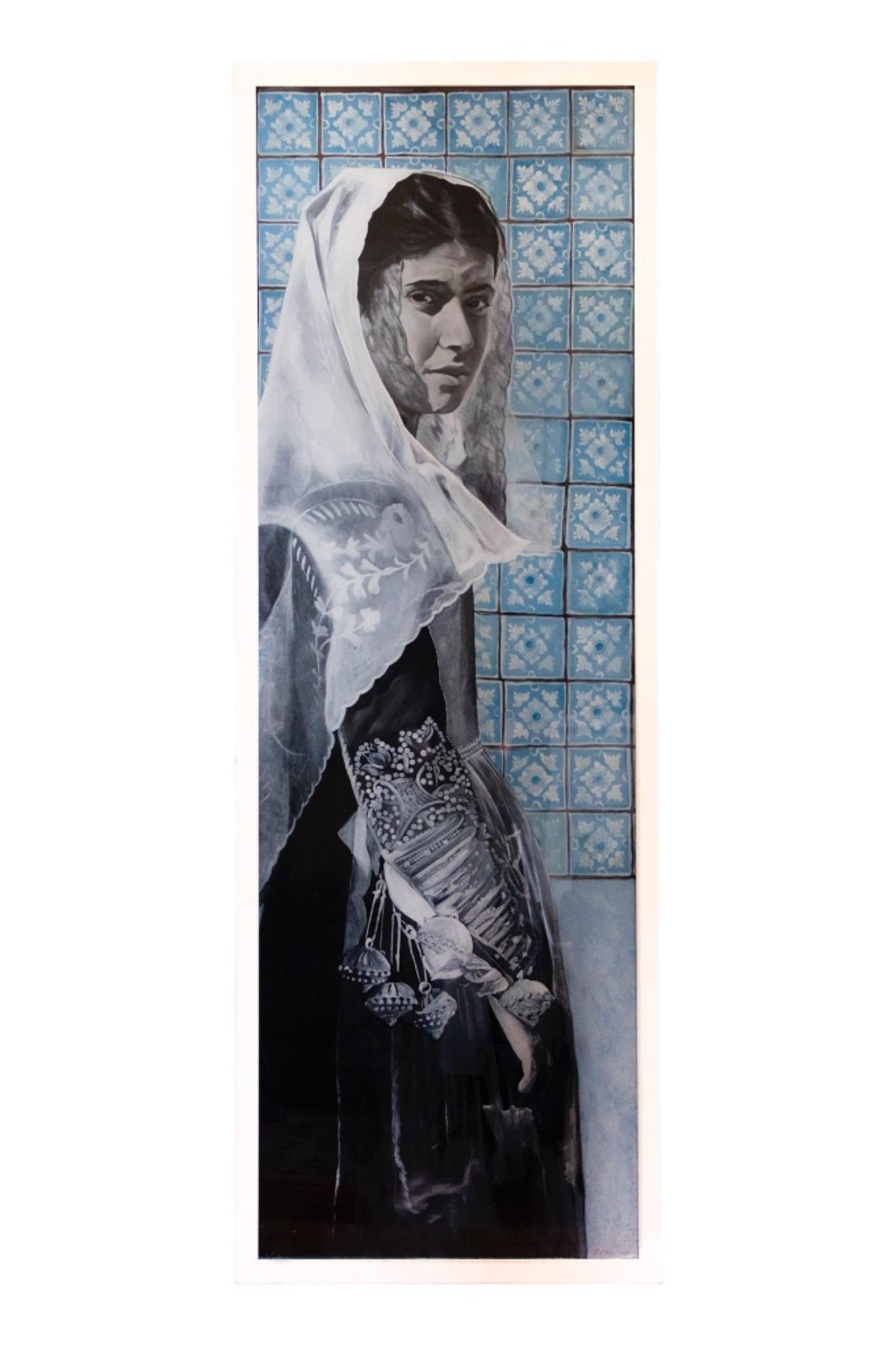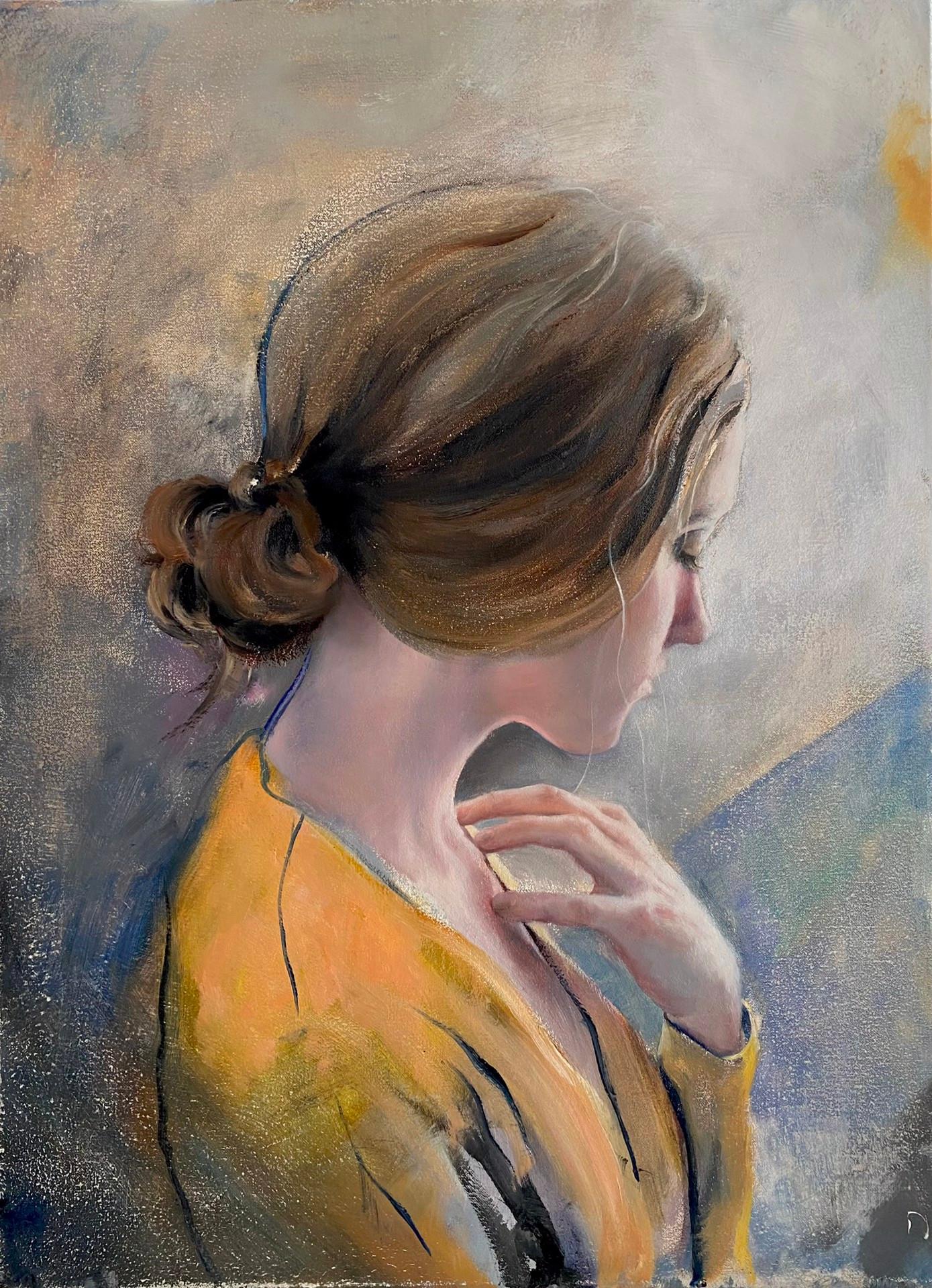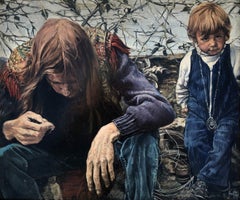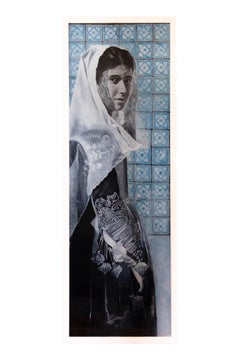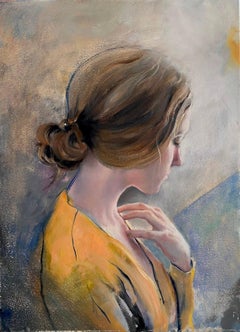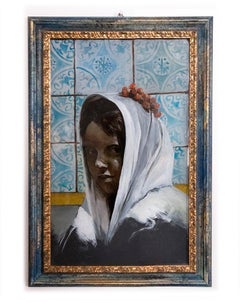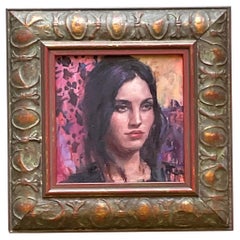Items Similar to Woman hippie original oil acrylic on canvas painting realism Spain Sitges 70s
Video Loading
Want more images or videos?
Request additional images or videos from the seller
1 of 13
José Luis FuentetajaWoman hippie original oil acrylic on canvas painting realism Spain Sitges 70sc.1980
c.1980
$2,395.48
$3,593.2233% Off
£1,775.18
£2,662.7733% Off
€2,000
€3,00033% Off
CA$3,270.28
CA$4,905.4333% Off
A$3,638.06
A$5,457.0933% Off
CHF 1,907.12
CHF 2,860.6733% Off
MX$44,456.18
MX$66,684.2733% Off
NOK 24,284.74
NOK 36,427.1133% Off
SEK 22,860.72
SEK 34,291.0833% Off
DKK 15,227.82
DKK 22,841.7433% Off
Shipping
Retrieving quote...The 1stDibs Promise:
Authenticity Guarantee,
Money-Back Guarantee,
24-Hour Cancellation
About the Item
Frame size 52x44
Is born in Madrid on the 21st july 1951.
After attending primary school, he starts to grow an enormous tendency for drawing.
At the age of 14 he begins to work in advertising and attends to the Vallecas school of arts.
At the age of 14 he travels to Switzerland and in Geneve he gets intensly into painting and decides to dedicate himself only to it.
When he returns to Spain he enrolls Arts Studies, and at the begining of summer '66, he visits Sitges, where he'll come back year after year and where ultimately he'll set his home.
At this time he starts selling his painting in the flea market in Madrid and later in Sitges, setting himself on the street, thus completing his studies and making it economically.
While he's in Madrid he recives lessons by Pedro Mozas at Bellas Artes and starts to learn profoundly about painting.
In 1969 he starts painting portraits in the streets.
In Sitges he creates, with other friends, a great artistic atmosphere in the Paseo de la Ribera, by the sea, that today still exists.
He starts travelling through Europe, visiting and painting in Paris, London and Amsterdam.
In the middle of this bohemian epoque, he moves to the Cannary Islands during the winters for 5 years in a row, he moves in the Parque de Santa Catalina "Las Palmas de Gran Canaria" where he works and meet all sorts of people in the streets, which later would mark his pictoric line.
He becomes friend with Sidney Nagley in 1969, who organizes his first exhibition in Toronto, Canada.
Afterwards he'll leave his studies and start painting exclusively in his studio.
He gathers his first exhibition in the Ateneu of Barcelona in 1970.
He befriends with the art critic of La Vanguardia, Fernando Gutierrez and the Count of Caralt orders him a set of illustration for a new edition of Garcia Lorcas Romancero Gitano.
His first exhibition in a commercial gallery is done in the Majestic Gallery in Barcelona with a gorgeous collection of nudity drawings.
He achieves huge success and for some years he affords his painting thanks to those drawings.
During a period in Madrid, Mr Ponce de León, a consul in the Ministry of Exterior Affairs grants him with bachelor degree to study in the prestigious Academia de España in Rome.
However, he can't accept it due to militar service obligations.
Some days later, before joining the ranks he opens in the Cuatre Gats (Palma de Mallorca) with hiperrealist pieces that already then he presented as the first painter in that city, that later would become a fashion in 1973.
After this period he meets José Maria Gudiol who advises positively.
Since then, the intense work and the fight for daily improvement that has become the trademark of his life. The seek of styles and situations, the journeys through Europe always aware of all the tendencies that have in the art line that we can see nowadays.
At his more than fifty years given to paint, his individual exhibitions beat the 100, his artwork is highly appreciated and valued in the complex market of art.
In October 1982 hi makes his first exhibition in Tarragona. In the catalogue, writing of the unforgettable Fernando Gutierrez, he says "Fuentetaja is an artist of character and exceptional upbringing with a masterly knowledge of technique and resourses, and personality completely uncommon to the dimension of his sensitivity, as the richness of his deep and bloomed liricism.
A judgement as accurate as foreseeing for the future outstanding of the artist, in where his paint soared through different phases mantaining an unquestionable quality. Lines, cubist, expressionist and hiperrealist till his current realism, in the middle of his creative maturity.
Jose Luis Fuentetaja has lived and overcome in his live hard stages, some of them very difficult that took him to feel tired and deceived by the Western World.
It's because of this that he made his first trip to India, which was extended for months and which became a major source of inner peace for his thoughts. Afterwards in practically 20 years he has returned there more than 25 occasions.
He has split every year into two halves, two studies, two atmospheres, the one in Sitges and the one in Calanguta (Goa), where at the arrival he salutes with his hands at chin height and his head slightly inclined and pronounces "Namasté" which preceeds the brotherly hug of the "meeting again".
The marvellous world of India and Nepal, Benares, Bombay, Katmandú, Jaipur, Kuri in his various atmospheres in his busyness and beauty, chromatic explosion, permanent festival for the eyes of light and color, even when the splandour of fantastic monuments and treasures can be found, side by side with the most terrible miseries. Becoming a part of the mundane, has inspired the artist.
A fascinating life that Jose Luis Fuentetaja has manage to capture in all its spontaneity, dedicated to the unstoppable pictoric labour of magical and vibrant realism.
Men and women, kids, lots of kids, houses, markets, surprising garments, secular jobs, liturgies, figure in this authentic plastic tradition of a singular universe that is the old Indostan, engaged in its ancestral experiences.
Una vida fascinante que Jose Luis Fuentetaja ha sabido captar en toda su espontaneidad, volcado en una infatigable lavor pictorica de magico y vibrante realismo.
Hombres y mujeres, niños, muchos niños, viviendas, mercados, sorprendentes indumentarias, oficios seculares, liturgias, figuran en esta autentica traducción plástica del singular universo que es el antiguo indostán, inmerso aun en sus ancentrales experiences.
During the last years, Fuentetaja has continued to pictoric pilgrimmage around plenty of places in America and Asia specially, making out of his experiences a plastic translation almost universal, all of those places divide his painting stages very definite, for example, the Caribean collection, Cuba, Venecia, Bali, Vietnam, Thailand and finally the last stage in which he's immerse, Birmania (Mianmar), its people and landscapes, trying to transmit the beauty of all those places through his paintings to the conscience of the Western World.
- Creator:José Luis Fuentetaja (1951, Spanish)
- Creation Year:c.1980
- Dimensions:Height: 13.78 in (35 cm)Width: 10.63 in (27 cm)
- Medium:
- Movement & Style:
- Period:
- Condition:
- Gallery Location:Barcelona, ES
- Reference Number:1stDibs: LU1155213324832
José Luis Fuentetaja
Is born in Madrid on the 21st july 1951.
After attending primary school, he starts to grow an enormous tendency for drawing. At the age of 14 he begins to work in advertising and attends to the Vallecas school of arts. At the age of 14 he travels to Switzerland and in Geneve he gets intensly into painting and decides to dedicate himself only to it.
When he returns to Spain he enrolls Arts Studies, and at the begining of summer '66, he visits Sitges, where he'll come back year after year and where ultimately he'll set his home. At this time he starts selling his painting in the flea market in Madrid and later in Sitges, setting himself on the street, thus completing his studies and making it economically. While he's in Madrid he recives lessons by Pedro Mozas at Bellas Artes and starts to learn profoundly about painting. In 1969 he starts painting portraits in the streets. In Sitges he creates, with other friends, a great artistic atmosphere in the Paseo de la Ribera, by the sea, that today still exists.
He starts travelling through Europe, visiting and painting in Paris, London and Amsterdam. In the middle of this bohemian epoque, he moves to the Cannary Islands during the winters for 5 years in a row, he moves in the Parque de Santa Catalina "Las Palmas de Gran Canaria" where he works and meet all sorts of people in the streets, which later would mark his pictoric line. He becomes friend with Sidney Nagley in 1969, who organizes his first exhibition in Toronto, Canada. Afterwards he'll leave his studies and start painting exclusively in his studio. He gathers his first exhibition in the Ateneu of Barcelona in 1970. He befriends with the art critic of La Vanguardia, Fernando Gutierrez and the Count of Caralt orders him a set of illustration for a new edition of Garcia Lorcas Romancero Gitano.
His first exhibition in a commercial gallery is done in the Majestic Gallery in Barcelona with a gorgeous collection of nudity drawings. He achieves huge success and for some years he affords his painting thanks to those drawings. During a period in Madrid, Mr Ponce de León, a consul in the Ministry of Exterior Affairs grants him with bachelor degree to study in the prestigious Academia de España in Rome. However, he can't accept it due to militar service obligations. Some days later, before joining the ranks he opens in the Cuatre Gats (Palma de Mallorca) with hiperrealist pieces that already then he presented as the first painter in that city, that later would become a fashion in 1973. After this period he meets José Maria Gudiol who advises positively. Since then, the intense work and the fight for daily improvement that has become the trademark of his life.
About the Seller
5.0
Platinum Seller
Premium sellers with a 4.7+ rating and 24-hour response times
Established in 2007
1stDibs seller since 2019
440 sales on 1stDibs
Typical response time: 1 hour
- ShippingRetrieving quote...Shipping from: sitges, Spain
- Return Policy
Authenticity Guarantee
In the unlikely event there’s an issue with an item’s authenticity, contact us within 1 year for a full refund. DetailsMoney-Back Guarantee
If your item is not as described, is damaged in transit, or does not arrive, contact us within 7 days for a full refund. Details24-Hour Cancellation
You have a 24-hour grace period in which to reconsider your purchase, with no questions asked.Vetted Professional Sellers
Our world-class sellers must adhere to strict standards for service and quality, maintaining the integrity of our listings.Price-Match Guarantee
If you find that a seller listed the same item for a lower price elsewhere, we’ll match it.Trusted Global Delivery
Our best-in-class carrier network provides specialized shipping options worldwide, including custom delivery.More From This Seller
View AllHippie Original oil acrylic on canvas painting realism Spain Sitges 70s
By José Luis Fuentetaja
Located in Barcelona, Barcelona
Frame size 52x44
Is born in Madrid on the 21st july 1951.
After attending primary school, he starts to grow an enormous tendency for drawing.
At the age of 14 he begins to work in advertising and attends to the Vallecas school of arts.
At the age of 14 he travels to Switzerland and in Geneve he gets intensly into painting and decides to dedicate himself only to it.
When he returns to Spain he enrolls Arts Studies, and at the begining of summer '66, he visits Sitges, where he'll come back year after year and where ultimately he'll set his home.
At this time he starts selling his painting in the flea market in Madrid and later in Sitges, setting himself on the street, thus completing his studies and making it economically.
While he's in Madrid he recives lessons by Pedro Mozas at Bellas Artes and starts to learn profoundly about painting.
In 1969 he starts painting portraits in the streets.
In Sitges he creates, with other friends, a great artistic atmosphere in the Paseo de la Ribera, by the sea, that today still exists.
He starts travelling through Europe, visiting and painting in Paris, London and Amsterdam.
In the middle of this bohemian epoque, he moves to the Cannary Islands during the winters for 5 years in a row, he moves in the Parque de Santa Catalina "Las Palmas de Gran Canaria" where he works and meet all sorts of people in the streets, which later would mark his pictoric line.
He becomes friend with Sidney Nagley in 1969, who organizes his first exhibition in Toronto, Canada.
Afterwards he'll leave his studies and start painting exclusively in his studio.
He gathers his first exhibition in the Ateneu of Barcelona in 1970.
He befriends with the art critic of La Vanguardia, Fernando Gutierrez and the Count of Caralt orders him a set of illustration for a new edition of Garcia Lorcas Romancero Gitano.
His first exhibition in a commercial gallery is done in the Majestic Gallery in Barcelona with a gorgeous collection of nudity drawings.
He achieves huge success and for some years he affords his painting thanks to those drawings.
During a period in Madrid, Mr Ponce de León, a consul in the Ministry of Exterior Affairs grants him with bachelor degree to study in the prestigious Academia de España in Rome.
However, he can't accept it due to militar service obligations.
Some days later, before joining the ranks he opens in the Cuatre Gats (Palma de Mallorca) with hiperrealist pieces that already then he presented as the first painter in that city, that later would become a fashion in 1973.
After this period he meets José Maria Gudiol who advises positively.
Since then, the intense work and the fight for daily improvement that has become the trademark of his life. The seek of styles and situations, the journeys through Europe always aware of all the tendencies that have in the art line that we can see nowadays.
At his more than fifty years given to paint, his individual exhibitions beat the 100, his artwork is highly appreciated and valued in the complex market of art.
In October 1982 hi makes his first exhibition in Tarragona. In the catalogue, writing of the unforgettable Fernando Gutierrez, he says "Fuentetaja is an artist of character and exceptional upbringing with a masterly knowledge of technique and resourses, and personality completely uncommon to the dimension of his sensitivity, as the richness of his deep and bloomed liricism.
A judgement as accurate as foreseeing for the future outstanding of the artist, in where his paint soared through different phases mantaining an unquestionable quality. Lines, cubist, expressionist and hiperrealist till his current realism, in the middle of his creative maturity.
Jose Luis Fuentetaja...
Category
1980s Realist Portrait Paintings
Materials
Canvas, Acrylic
Hippies - Original oil acrylic painting realism
By José Luis Fuentetaja
Located in Barcelona, Barcelona
Frame size 48x53
Is born in Madrid on the 21st july 1951.
After attending primary school, he starts to grow an enormous tendency for drawing.
At the age of 14 he begins to work in ...
Category
1980s Realist Paintings
Materials
Acrylic
$5,749 Sale Price
43% Off
gypsy woman oil on canvas painting
By Josep Serrasanta
Located in Barcelona, Barcelona
Josep Serrasanta (1916-1998) - Gypsy woman - Oil on canvas
Oil measures 65x50 cm.
Frame measures 88x73 cm.
Josep Serrasanta was born in Buenos Aires (Argentina) in 1916 - 1998 Valdo...
Category
1980s Post-Impressionist Figurative Paintings
Materials
Oil, Canvas
Paternity oil acrylic on canvas painting realism Spain Sitges 70s
By José Luis Fuentetaja
Located in Barcelona, Barcelona
Frameless.
Is born in Madrid on the 21st july 1951.
After attending primary school, he starts to grow an enormous tendency for drawing.
At the age of 14 he begins to work in advertising and attends to the Vallecas school of arts.
At the age of 14 he travels to Switzerland and in Geneve he gets intensly into painting and decides to dedicate himself only to it.
When he returns to Spain he enrolls Arts Studies, and at the begining of summer '66, he visits Sitges, where he'll come back year after year and where ultimately he'll set his home.
At this time he starts selling his painting in the flea market in Madrid and later in Sitges, setting himself on the street, thus completing his studies and making it economically.
While he's in Madrid he recives lessons by Pedro Mozas at Bellas Artes and starts to learn profoundly about painting.
In 1969 he starts painting portraits in the streets.
In Sitges he creates, with other friends, a great artistic atmosphere in the Paseo de la Ribera, by the sea, that today still exists.
He starts travelling through Europe, visiting and painting in Paris, London and Amsterdam.
In the middle of this bohemian epoque, he moves to the Cannary Islands during the winters for 5 years in a row, he moves in the Parque de Santa Catalina "Las Palmas de Gran Canaria" where he works and meet all sorts of people in the streets, which later would mark his pictoric line.
He becomes friend with Sidney Nagley in 1969, who organizes his first exhibition in Toronto, Canada.
Afterwards he'll leave his studies and start painting exclusively in his studio.
He gathers his first exhibition in the Ateneu of Barcelona in 1970.
He befriends with the art critic of La Vanguardia, Fernando Gutierrez and the Count of Caralt orders him a set of illustration for a new edition of Garcia Lorcas Romancero Gitano.
His first exhibition in a commercial gallery is done in the Majestic Gallery in Barcelona with a gorgeous collection of nudity drawings.
He achieves huge success and for some years he affords his painting thanks to those drawings.
During a period in Madrid, Mr Ponce de León, a consul in the Ministry of Exterior Affairs grants him with bachelor degree to study in the prestigious Academia de España in Rome.
However, he can't accept it due to militar service obligations.
Some days later, before joining the ranks he opens in the Cuatre Gats (Palma de Mallorca) with hiperrealist pieces that already then he presented as the first painter in that city, that later would become a fashion in 1973.
After this period he meets José Maria Gudiol who advises positively.
Since then, the intense work and the fight for daily improvement that has become the trademark of his life. The seek of styles and situations, the journeys through Europe always aware of all the tendencies that have in the art line that we can see nowadays.
At his more than fifty years given to paint, his individual exhibitions beat the 100, his artwork is highly appreciated and valued in the complex market of art.
In October 1982 hi makes his first exhibition in Tarragona. In the catalogue, writing of the unforgettable Fernando Gutierrez, he says "Fuentetaja is an artist of character and exceptional upbringing with a masterly knowledge of technique and resourses, and personality completely uncommon to the dimension of his sensitivity, as the richness of his deep and bloomed liricism.
A judgement as accurate as foreseeing for the future outstanding of the artist, in where his paint soared through different phases mantaining an unquestionable quality. Lines, cubist, expressionist and hiperrealist till his current realism, in the middle of his creative maturity.
Jose Luis Fuentetaja...
Category
1980s Realist Portrait Paintings
Materials
Acrylic, Canvas
$2,275 Sale Price
36% Off
Maternity mixed media on canvas Nepal
By José Luis Fuentetaja
Located in Barcelona, Barcelona
Jose Luis Fuentetaja - Maternity - mixed media (print and oil on canvas).
Canvas size 54x65 cm.
Frameless.
Is born in Madrid on the 21st july 195...
Category
1990s Realist Portrait Paintings
Materials
Canvas, Mixed Media
$359 Sale Price
50% Off
Pensive Woman oil on canvas painting european art
By Frederic Lloveras Herrera
Located in Barcelona, Barcelona
Title: Pensive Woman
Artist: Frederic Lloveras Herrera (1912–1983)
Year: 1980
Technique: Oil on canvas
Dimensions: 28.7 x 23.6 in (73 x 60 cm)
Support: Canvas, unframed
Signature: Si...
Category
1980s Impressionist Portrait Paintings
Materials
Canvas, Oil
$1,197 Sale Price
33% Off
You May Also Like
Female Portrait - Oil Painting by Roberto De Francisci - 2010s
Located in Roma, IT
Female Portrait is an original Contemporary artwork realized in the 2010s by the Italian artist Roberto De Francisci (b. 1976, Medellin, Colombia)...
Category
2010s Portrait Paintings
Materials
Oil, Glass
"Patience" - Original Oil of Thoughtful Woman by James Van Fossan
By James Van Fossan
Located in Denver, CO
James Van Fossan’s “Patience” (2024) is a striking oil on linen portrait, measuring 19 x 14 inches. This unframed artwork, which is ready to hang, captures the serene, contemplative ...
Category
2010s Realist Figurative Drawings and Watercolors
Materials
Linen, Oil
$1,875 Sale Price
25% Off
Woman From Sciacca - Oil Painting by Roberto De Francisci - 2010s
Located in Roma, IT
Woman From Sciacca is an original Contemporary artwork realized in the 2010s by the Italian artist Roberto De Francisci (b. 1976, Medellin, Colomb...
Category
2010s Portrait Paintings
Materials
Oil
Vintage Boho Signed Original Oil Painting on Board of Woman
Located in West Palm Beach, FL
A fantastic vintage Boho original oil painting on board. A chic little portrait in brilliant bright colors. Done by the LA artist Natalia Fabia. Acquired from a Palm Beach estate.
Category
21st Century and Contemporary North American Bohemian Paintings
Materials
Paint
Modern American Figurative Gypsy Woman Oil Painting Painting
Located in Douglas Manor, NY
5-3238a Gypsey figurative oil painting on artist board set in a vintage gilt frame
Category
1980s Figurative Paintings
Materials
Oil
Woman - Oil Painting by Leo Guida - 1970s
By Leo Guida
Located in Roma, IT
Woman is an original contemporary artwork realized by Leo Guida in 1970s
Mixed colored oil painting on canvas.
Leo Guida (1992 - 2017). Sensitive to current issues, artistic movem...
Category
1970s Contemporary Figurative Paintings
Materials
Oil
More Ways To Browse
70s Spanish
Oil Portrait Spanish Woman
Hippie Art
C Garcia
Vintage Treasure Island
70s Divider
Vintage Hippie Art
Judgement Of Paris
Vintage Nudity
Paris Flea Market
Catalina Island
Catalina Island Painting
British Military Portrait
Middle Eastern Portrait
Portrait Collar Dress
Art Deco Female Portrait
17th Century Oil On Panel Portrait
Empress Portrait
